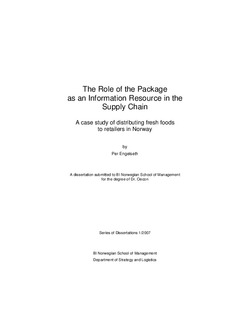| dc.description.abstract | The objective of this study is to investigate the role of the package as an information resource in a supply chain context. The package is a physical resource that is designed in accordance with principles of packaging technology. This study concentrates on the package regarded as a logistics resource. This role of the package involves functions regarding how packages carry goods, provide utility in relation to logistics activities, and facilitate communication. In this study focus is directed to communicative aspects of using packages.
Within logistics and supply chain management studies regarding using packages have mainly been directed towards how packages carry goods. In a supply chain the package may be therefore be regarded as a core logistics resource since it facilitates the provision of products to an end user. This view is also based upon that when goods are packed, the goods themselves are concealed, and therefore it is packages, and not the goods themselves that need to be accounted for. In addition, packages serve a vital purpose as a marketing resource in a retail setting and when informing about products in a purchasing situation.
The use of the package as an information resource is described as an interplay between, the package, information and the transformation of goods. This interplay is used to structure the frame of reference and to design the research process. Empirical findings are based on four cases concerning the distribution of four fresh food products to Norwegian retailers. The studied products are 1) seasonal strawberries, 2) low-fat milk, 3) packed fresh fish, and 4) bananas from Costa Rica. These four products are studied in the supply chains of two Norwegian distribution networks; 1) BAMA, a distributor of fresh fruits and vegetables, and 2) TINE, a producer and distributor of predominately dairy products.
In a supply chain consisting of different actors, informational needs vary. Descriptions of packages impact on how information is provided and used for different purposes. The main findings of this study involve how the package through playing a vital role embedded in the core flow of goods facilitates information exchange and the transformation of information about goods adapted to user needs. The package is a logistics resource that mediates between variations in actor needs and different logistics activities in a network of supply chain actors. | en |
